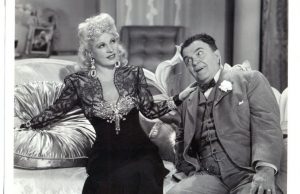Once In a Lifetime (1932)

Toronto Film Society presented Once In a Lifetime (1932) on Sunday, December 4, 1988 in a double bill with Harvey as part of the Season 41 Sunday Afternoon Film Buffs Series “A”, Programme 3.
Toronto Film Society presented Once In a Lifetime (1932) on Monday, July 11, 1983 in a double bill with Singin’ In the Rain as part of the Season 36 Summer Series, Programme 4.
Production Company: Universal. Producer: Carl Laemmle, Jr. Director: Russell Mack. Screenplay: Seton I. Miller, based on the play by Moss Hart & George S. Kaufman. Camera: George Robinson.
Cast: Jack Oakie (George Lewis), Sidney Fox (Susan Walker), ZaSu Pitts (Miss Leighton), Louise Fazenda (Helen Hobart), Gregory Ratoff (Herman Glogauer), Onslow Stevens (Lawrence Vail), Claudi Morgan (Miss Chasen), Gregory Gaye (Rudolph Kammerling), Edward Kane (Meterstein), Johnnie Morris (Weisskopf), Mona Maris (Phyllis Fontaine), Carol Tevis (Florabel Leigh), Frank LaRue (Sign painter).
In 1930 a very young Moss Hart wrote the play Once In a Lifetime. On the advise of Broadway producer Jed Harris he took it to George S. Kaufman, who liked it enough to become Hart’s collaborator in the revision and improvement of the material. It opened on Broadway in September 1930 and was a smash hit. It was the first of eight plays by Kaufman and Hart, followed by (among others) You Can’t Take It With You (1936), I’d Rather Be Right (1937) and The Man Who Came To Dinner (1939). Kaufman also co-wrote and directed such Broadway hits as Of Thee I Sing (1931), Dinner at Eight (1932), Stage Door (1936), The Solid Gold Cadillac (1953) and Silk Stockings (1955), to name just a few examples of this gifted man’s enormous output. In 1935 Irving Thalberg offered Kaufman a staggering $100,000 to write a single picture, so in between writing and staging First Lady with Katherine Dayton and Stage Door with Edna Ferber, he went to Hollywood and wrote A Night at the Opera for Thalberg, The Marx Brothers and MGM. Once at the studio he was given the treatment that five years earlier, in One In a Lifetime, he had predicted would be the lot of playwrights in Hollywood. Many of filmland’s wits had sport with the institution of ‘Waiting for Irving’ but it remained for Kaufman, who also served his time wating on the million-dollar-bench to originate the line, “On a clear day you can see Thalberg”.
Moss Hart had never been to Hollywood and admitted that his entire knowledge of the picture business came from reading Variety. With Kaufman’s revisions, the play that resulted was one of the most brilliant satires ever devised about the movie world. It was thought that the play was so severe in its lampooning of Hollywood that it would never be filmed, but Universal, to its credit, filmed the story intact from a screenplay by Seton Miller. Basically, it is the story of three undistinguished vaudevillians who plan to invade Holllywood as experts on voice culture, something they know absolutely nothing about. With the advent of sound, Hollywood was besieged with phoney elocution experts, who turned the confusion around them to their advantage. Aboard a westbourn train, the trio meet a powerful gossip columnist and wangle the necessary professional introductions. All the typical Hollywood “types” are encountered; the studio mogul (Gregory Ratoff), a couple of bird-brained actresses (Carol Tevis & Mona Maris), an unflappable receptionist with a short memory (ZaSu Pitts), and a writer (Onslow Stevens) who has been on full salary for six months without seeing the studio boss or writing a line. (In the Broadway play, George S. Kaufman himself played the role of the frustrated writer, Lawrence Vail, prelude to his treatment in Hollywood by Thalberg, as already noted).

Through sheer, dauntless stupidity, one of the trio, George Lewis (played by Jack Oakie) becomes an important figure at the studio who can do no wrong. He tells the mogul that Hollywood is run by a bunch of fools–and ends up as a supervising producer. He then incorrectly remakes a 1910 Biograph one-reeler into something called Gingham and Orchids, forgetting to light part of the set and accidentally adding sound effects by his continual nut-cracking during shooting. The mogul’s rage is quickly modified when the film is hailed as a critical success, with every absurd mistake taken for an inspiration or innovation: “A return to the sweet simplicity of yesteryear… At last, an actress who is not afraid to appear awkward and ungraceful… The originality of the lighting, with the climaxes played in the dark. In the opening sequences the audience was puzzled by a constant knocking–then suddenly we realized it was what O’Neill did with the beating of the tom-tom in The Emperor Jones. It was the beat of hail on the roof.” (Actually, George cracking nuts). When George idiotically orders 2,000 planes for a war movie, instead of it being financial folly it turns out that he has cornered the market and all other studios must now rent planes from his studio, for high fees.
Oakie is hilarious as the jovial nitwit, George, but he receives good support from Aline MacMahon, who adds her dry humour to the clever portrayal of vocal-culture “expert” May Daniels. Gregory Ratoff gives a marvelous performance as the apoplectic studio mogul, similar to his role in What Price Hollywood? but much wilder. He quite obviously enjoyed playing Glogauer, so we will leave the final word to him from a scene when he finds his producer has made the wrong film: “Never in my life have I known such a thing! After this I make a ruling–every scenario we produce, somebody has got to read it.”
Source material: Hollywood’s Hollywood by Rudy Behlmer & Tony Thomas, Citadel Press, 1975;
George S. Kaufman: An Intimate Portrait by Howard Teichmann, Atheneum Press, 1972;
Hollywood on Hollywood by Robert Parish & Michael Pitts, Scarecrow Press, 1978.
Notes by Barry Chapman










Leave a Reply